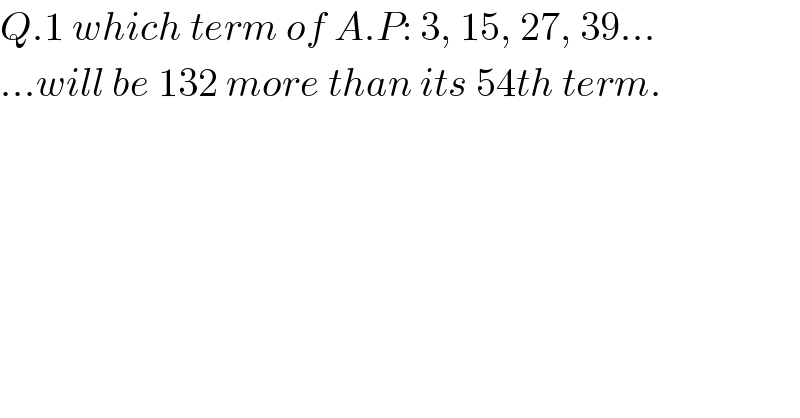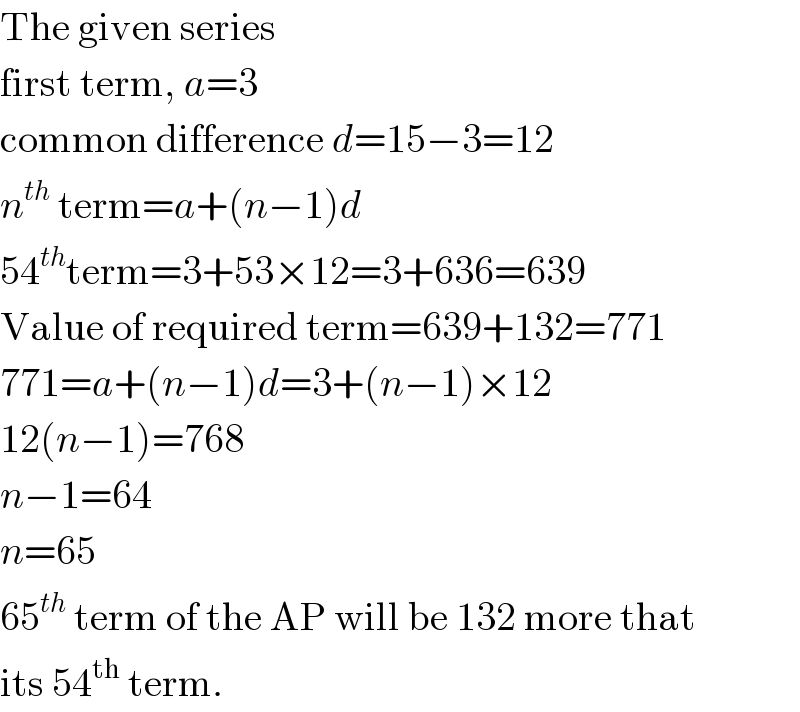
Question Number 7697 by Rohit 57 last updated on 09/Sep/16

$${Q}.\mathrm{1}\:{which}\:{term}\:{of}\:{A}.{P}:\:\mathrm{3},\:\mathrm{15},\:\mathrm{27},\:\mathrm{39}... \\ $$$$...{will}\:{be}\:\mathrm{132}\:{more}\:{than}\:{its}\:\mathrm{54}{th}\:{term}. \\ $$
Commented by prakash jain last updated on 09/Sep/16

$$\mathrm{The}\:\mathrm{given}\:\mathrm{series} \\ $$$$\mathrm{first}\:\mathrm{term},\:{a}=\mathrm{3} \\ $$$$\mathrm{common}\:\mathrm{difference}\:{d}=\mathrm{15}−\mathrm{3}=\mathrm{12} \\ $$$${n}^{{th}} \:\mathrm{term}={a}+\left({n}−\mathrm{1}\right){d} \\ $$$$\mathrm{54}^{{th}} \mathrm{term}=\mathrm{3}+\mathrm{53}×\mathrm{12}=\mathrm{3}+\mathrm{636}=\mathrm{639} \\ $$$$\mathrm{Value}\:\mathrm{of}\:\mathrm{required}\:\mathrm{term}=\mathrm{639}+\mathrm{132}=\mathrm{771} \\ $$$$\mathrm{771}={a}+\left({n}−\mathrm{1}\right){d}=\mathrm{3}+\left({n}−\mathrm{1}\right)×\mathrm{12} \\ $$$$\mathrm{12}\left({n}−\mathrm{1}\right)=\mathrm{768} \\ $$$${n}−\mathrm{1}=\mathrm{64} \\ $$$${n}=\mathrm{65} \\ $$$$\mathrm{65}^{{th}} \:\mathrm{term}\:\mathrm{of}\:\mathrm{the}\:\mathrm{AP}\:\mathrm{will}\:\mathrm{be}\:\mathrm{132}\:\mathrm{more}\:\mathrm{that} \\ $$$$\mathrm{its}\:\mathrm{54}^{\mathrm{th}} \:\mathrm{term}. \\ $$
Commented by Rohit 57 last updated on 10/Sep/16

$${thanku}\:{sir} \\ $$
Commented by Rasheed Soomro last updated on 11/Sep/16
![−−−−−−−−−−−−−−−−−−−−−−−−−−− Another way d=15−3=12 132=(((132)/(12)))×12=11d Requieed term=54th term+132=54th term+11d =(54+11)th term=65th term pth trrm+qd=(p+q)th term [a+(p−1)d+qd=a+(p+q^(−) −1)d]](Q7700.png)
$$−−−−−−−−−−−−−−−−−−−−−−−−−−− \\ $$$${Another}\:{way} \\ $$$${d}=\mathrm{15}−\mathrm{3}=\mathrm{12} \\ $$$$\mathrm{132}=\left(\frac{\mathrm{132}}{\mathrm{12}}\right)×\mathrm{12}=\mathrm{11}{d} \\ $$$${Requieed}\:{term}=\mathrm{54}{th}\:{term}+\mathrm{132}=\mathrm{54}{th}\:{term}+\mathrm{11}{d} \\ $$$$\:\:\:\:\:\:\:\:\:\:\:\:=\left(\mathrm{54}+\mathrm{11}\right){th}\:{term}=\mathrm{65}{th}\:{term} \\ $$$$\:\:\:\:\:\:\:\:{pth}\:{trrm}+{qd}=\left({p}+{q}\right){th}\:{term} \\ $$$$\:\:\:\:\:\left[{a}+\left({p}−\mathrm{1}\right){d}+{qd}={a}+\left(\overline {{p}+{q}}\:−\mathrm{1}\right){d}\right] \\ $$
